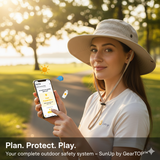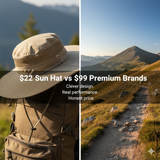
If you’re the type that wants an all-year glow or just simply feeling tangry - a state of anger caused by being pale - I bet you’re thinking about driving to a nearby tanning salon and hopping in the next available tanning bed and coming out like a bronzed goddess.
What are the different types of UV rays?
Before you start catching some rays and deep dive into the world of indoor tanning, let us first know more about UV radiations:
UVA
Ultraviolet A has longer wavelengths which penetrate the skin more deeply. Around 95% of UV radiation in the atmosphere is UVA. This radiation causes aging (UVAging)
UVB
Ultraviolet B has shorter wavelengths and higher energy levels than UVAs. UVB radiation only penetrates the topmost layer of your skin. About 5% of UV radiation in the atmosphere is UVB. This type of radiation causes skin burning (UVBurning)
What are 5 surprising facts about indoor tanning?
Now that we got that hot topic covered, here are 5 surprising facts about indoor tanning you should know:
1. Tanning beds aren't a good source of vitamin D
Most of us would assume that indoor tanning is a good alternative for the sun and you get all the benefits of staying under the sun likevitamin D. Nope. It doesn’t give you a “healthy” glow. While the sun emits both UVA and UVB lights, your tanning beds mostly emit UVA rays and minimal to no UVB rays.
For the body to produce Vitamin D, UVB has to be present. Best to go outdoors and enjoy the sun but still use maximum protection by applying sunscreen andwearing your favorite sun hats.
2. Base tans from indoor tanning won’t protect you from the sun
If this ain’t your first rodeo, you’ve probably heard someone say that getting a base tan will help protect you from sunburn. That is an outright myth that’s about to be busted.
Whether you’re tanning indoors or outdoors, every time you tan or burn, you are also damaging your DNA which makes your skin vulnerable to skin cancer. Don’t be scared to go out in the sun though as long as you have the right protection!
3. Indoor tanning increases the risk of skin cancer
UV radiation in general causes skin cancer under prolonged exposure - both UVA and UVB. Five minutes under UVA lamps is equivalent to 1 hour at the beach. Imagine how strong those light bulbs are.
For a machine that mostly emits UVA (you know, the UV ray that causes aging, not burning), how does it cause skin burns? There are more chances of you developing skin cancer if you do this every week rather than taking a quick walk outside. Make sure youchoose your sun hat that has UPF 50+ sun protection.
4. Indoor tanning causes premature aging
For you to be able to get a visible glow, you would need to go to 3-5 sessions and then do weekly maintenance of 1-2 visits. Prolonged unprotected exposure breaks down your skin collagen and elastin fibers which would result in loosened folds and wrinkles, leading topremature aging. Imagine all that damage and money with the minimal color payoff.
5. Indoor tanning can cause injuries
Tanning bed-related injuries are more common than you think - more than 3,000 emergency visits across America! Either from burns, eye injuries, or loss of consciousness, your next visit may be to the hospital bed rather than the tanning bed.
Whether you’re doing lamps, beds, or booths, indoor tanning has its “quick” results but may cause long-term damage.
Conclusion
We recommend you enjoy your time outdoors but protect your skin at the same time. Explore the world and discover everything you need to know under the sun with the rightsunscreen protection both by using sunblock and the right gear.
You cancheck out our GearTOP essentials and know more about sun protection byvisiting our blog.
Did you like this article? Let us know what you think by writing a comment below.





Leave a comment (all fields required)